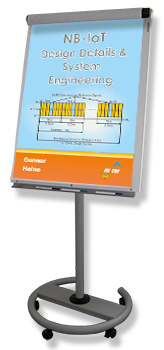 NB-IoT -
Design Details & System Engineering
NB-IoT -
Design Details & System Engineering
[2-day course, Euro 2,350.- (net) per participant]

Chapter 1: Introduction, Playground and Alternatives of NB-IoT (1 – 2 h)
- The IoT-marketplace in terms of use cases, numbers and volume
- Long range vs short range IoT-technologies
- Differences among NB-IoT, EC-GSM and CAT-M1
- How to define and determine the QoS in IoT-environments
- Introducing NB-IoT network architecture
- High level operation of selected use cases in NB-IoT
Pet tracking, metering and others, considering IoT-specifics like high latency communication HLComm, eDRX and PSM
Chapter 2: Diving into the Physical Layer of NB-IoT (4 – 5 h)
- Introducing Maximum Coupling Loss, Link Budget, Receiver Sensitivity and Signal to Noise Ratio
MCL in genuine LTE for different channels, MCL in NB-IoT for different channels
- How to determine the coverage area of a radio system
- Coverage enhancements in NB-IoT
Focus is on the use, simulation and operation of blind repetitions
- The Downlink OFDMA-grid in NB-IoT
- Allocation and Permutation of physical signals and channels to the OFDMA-grid
e.g. PSS; SSS, NPDSCH, NPDCCH, ...
- Uplink options and their operation and characteristics
Single-tone 3.75 kHz, single-tone 15 kHz and multi-tone 12x15 kHz, reference signals, modulation and symbols
- Operation of the NPRACH
The random-access procedure in the PHY of NB-IoT
- Channel coding and HARQ in NB-IoT
TBCC and turbo coding
Chapter 3: Protocol Stack and Operation of NB-IoT (3 – 4 h)
- Protocol Stack of NB-IoT
Control Plane and User Plane
- Cell Search, Random Access and RRC-connection establishment in NB-IoT
- Changes to protocols and their functions
MAC, RLC, PDCP, …
- Attachment of an NB-IoT UE to the network
Basic procedure, specifics of NB-IoT, discussion of options and timer values for PSM and eDRX
- eDRX and PSM in operation
Specifics and differences
- Device triggering
MSISDN-less operation
- Data transfer through the user plane
User plane CIoT Optimizations
- Data transfer through the control plane
Control plane CIoT Optimizations
- Security in NB-IoT
Use of SIM and future, key generation, distribution and update, operation
Chapter 4: Performance Analysis and Use Cases (3 – 4 h)
- Calculating the real user throughput rates under ideal conditions
taking the previous chapters into account
- Calculating battery lifetimes for different use cases
- Calculating throughput rates and latencies for different conditions
- Applicability of NB-IoT or alternative technologies like CAT-M1 for different use cases and different conditions
v1.000
ℹ️ Try out the updated search below!
Search:
More Info:
General Information about this course
Schedule of this training course
Our Training-Catalog
GSM Training Courses
(E)GPRS Training Courses
3G Training Courses
Multimedia & TCP/IP Training Courses
SS7 Protocol Stack Training Courses
Transmission & Access Technologies Related Courses
Bootcamps
